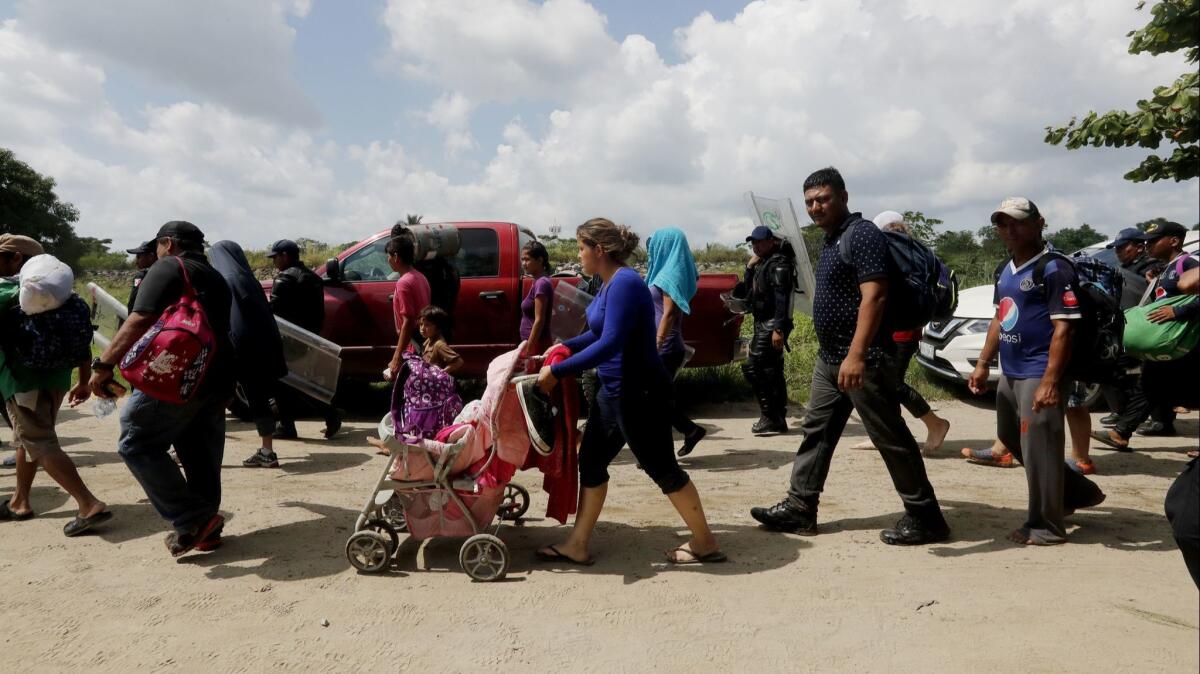Op-Ed: If other countries can balance human rights and border security, so can the United States

- Share via
Whatever concerns motivated thousands of Central American migrants to form a caravan to the United States in the last few weeks, their trek has undeniably become a political demonstration and media circus.
The caravan couldn’t have been better timed to stir anti-immigrant frenzy days before a critical midterm election. On Monday, in clashes between caravan trekkers and Mexican border guards at the Mexico-Guatemala border, a migrant died. In Washington, the Trump administration announced it had begun deploying more than 5,000 active duty troops to keep the asylum seekers and migrants out of the U.S.
The caravan raises real issues on all sides of the immigration debate. Both the United States and Mexico express legitimate concerns that larger-than-normal groups crossing borders represent a security threat. The caravan may contribute to domestic problems, including homelessness, and each government rightly wonders what it owes foreigners. The United States also asks whether Mexico, the country of transit, ought to take responsibility for screening asylum seekers.
On the other side, the well-documented failure of El Salvador, Honduras and Guatemala to protect their people from violence and abuse — in part perpetrated by U.S.-funded and trained security forces — establishes bona fide grounds for at least some trekkers to seek asylum.
There is a U.S. immigration backlog of about 750,000 cases.
Can these competing concerns be reconciled? Are we faced, as some politicians suggest, with a binary choice between completely open or completely closed borders?
We have answers from history and current practice. At the close of World War II, when the Universal Declaration of Human Rights was agreed upon as the foundation for a more humane world order, the tension between state sovereignty and individual rights was reflected in a paradox: The declaration enshrined the right of anyone to leave one country, but it did not guarantee a right to enter another. There was an exception: the right to seek and enjoy asylum from persecution.
No country wants a refugee influx. Lebanon didn’t ask to add to its population a million Syrians fleeing war. Bangladesh didn’t invite 700,000 Rohingya refugees to cross from Myanmar over the course of a few weeks last year. Colombia didn’t authorize 3,000 Venezuelans to enter every day in recent months.
But these and other countries have tried, however imperfectly, to strike the balance required to protect refugees, most commonly with blanket temporary protection while restricting migrants’ movements or otherwise screening them for security threats. Germany, which received 772,400 asylum applications during the mass migration of 2016, took a different approach, making 573,600 individual decisions in 2017. By contrast, the United States received 331,700 new asylum applications in 2017 and only made substantive decisions on 65,600 cases. There is a U.S. immigration backlog of about 750,000 cases.
Refugees have the right to seek asylum, but not the right to choose the asylum country. The United States has a safe-third-country agreement with Canada. It can decline to examine an asylum claim of someone travelling through Canada, because Canada, with comparable standards and procedures, has committed to taking that responsibility. But that’s not the case with Mexico. Although Mexico’s asylum system has improved in recent years, its police and immigration forces continue to block access to its under-resourced asylum procedures. Mexico cannot now be relied upon to provide effective protection to asylum seekers.
Enter the Fray: First takes on the news of the minute from L.A. Times Opinion »
In dealing with a mass influx, U.S. courts have given authorities great leeway to detain people while assessing their claims. The government used that leeway during the 125,000-person Mariel boatlift from Cuba in 1980. But do several thousand people walking 1,400 miles, in fact, represent a mass influx? During the last decade, the United States has apprehended on average 450,000 irregular border-crossers yearly — about 1,200 people per day — and placed them in deportation proceedings. It’s not clear that the caravan would represent a massively larger influx.
Detention is an option for those who could be dangerous or who might not show up for court proceedings, but reasonable and effective alternatives to detention exist, including community-supported release. Data show that when asylum seekers have confidence that a system is in place that will provide protection to those who qualify, they are not likely to abscond.
Like other refugee-receiving countries, the United States did not ask for this challenge. But as much as the U.S. has the right to decide who is allowed to enter and stay within its borders, it is also obligated by treaty not to return anyone, no matter their economic circumstances, to face real threats to their lives and freedom. How it treats those escaping poverty and misery, but not persecution and conflict, is a political choice that hinges on humanitarian considerations and economic interests, not legal obligation.
In neither case is the choice simply a matter of open or closed borders. It is instead about managing migration and human rights. Securing borders is not incompatible with protecting refugees. The United States, like other countries, is capable of doing both.
Bill Frelick is the refugee rights director at Human Rights Watch.
Follow the Opinion section on Twitter @latimesopinion and Facebook.
More to Read
A cure for the common opinion
Get thought-provoking perspectives with our weekly newsletter.
You may occasionally receive promotional content from the Los Angeles Times.









